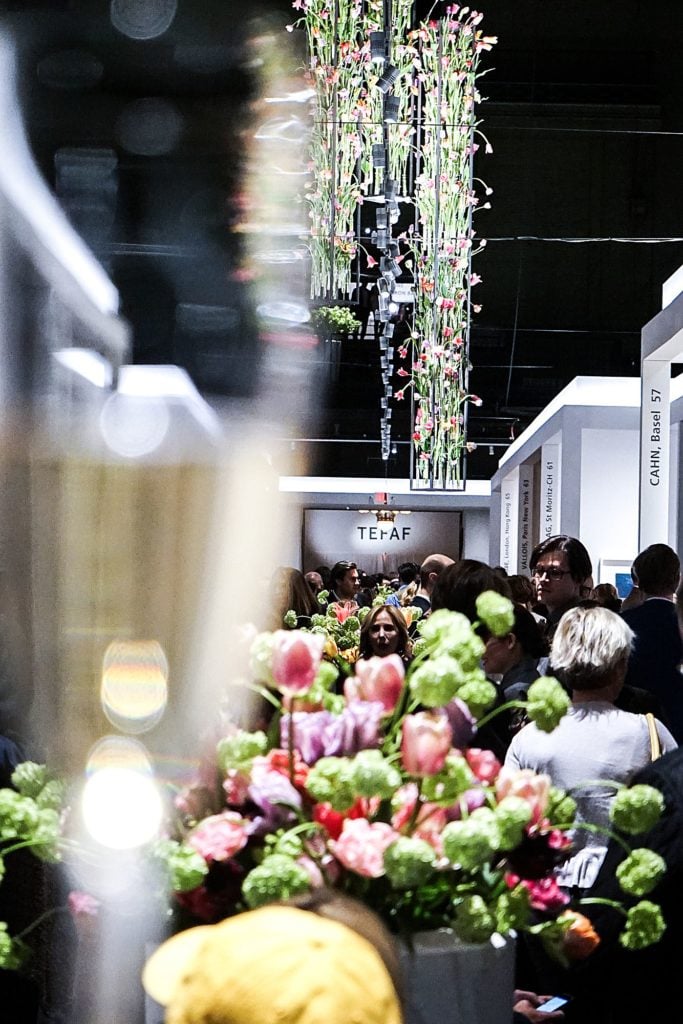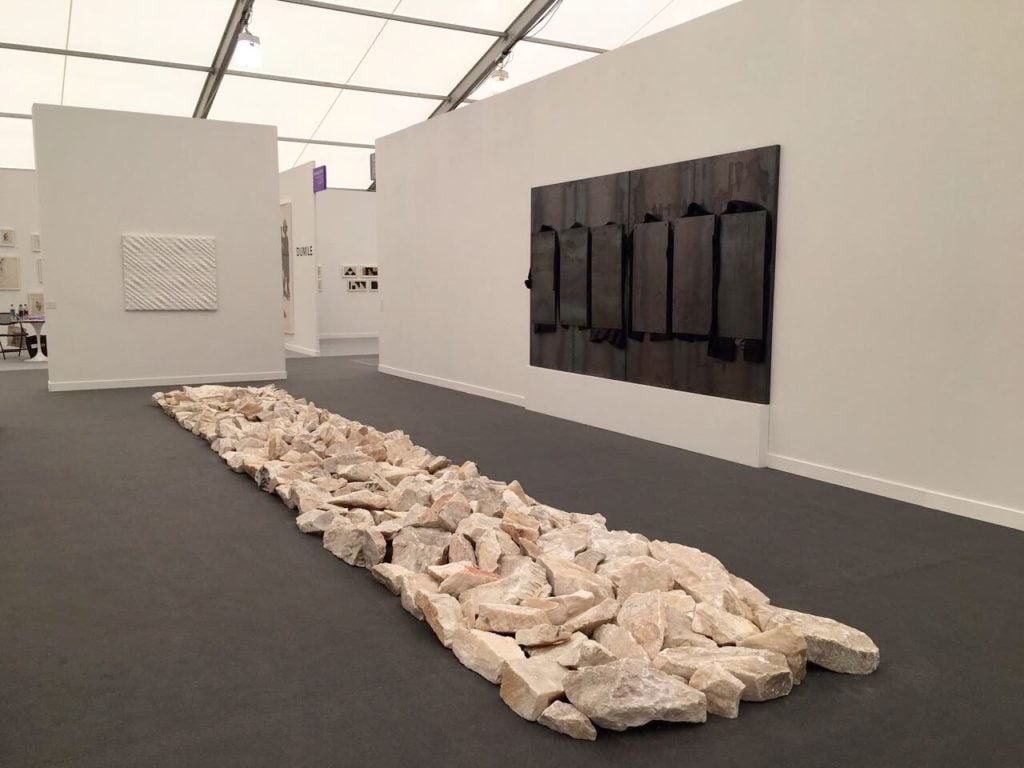Art Fairs
Frieze New York and TEFAF Force Dealers to Double Up—But Is it Sustainable?
Fourteen dealers participated in both fairs simultaneously; 10 of those already have a permanent gallery space in New York.

Fourteen dealers participated in both fairs simultaneously; 10 of those already have a permanent gallery space in New York.

Eileen Kinsella &
Julia Halperin

Some might say New York needs another art fair like it needs another Trump-branded condo building. But if the reviews of the inaugural spring edition of the European Fine Art Fair (TEFAF), which closed at the Park Avenue Armory today, are any indication, the city’s art market will be able to sustain the new addition to its increasingly crowded fair landscape.
The high number of dealers who participated in both TEFAF and Frieze New York, which closed its sixth edition yesterday, is a powerful sign of just how important fairs remain to galleries’ bottom lines. All told, 14 dealers participated in both fairs simultaneously; 10 of those also have at least one permanent gallery space in New York.
“I think you have to be strategic…but we’ll continue to do both,” says David Leiber of David Zwirner Gallery, which showed works by Ruth Asawa and Anni and Josef Albers at TEFAF. (In addition to six works by Asawa and two by Anni Albers, the gallery sold an Homage to the Square painting by Josef Albers with an asking price of $2.2 million.) Meanwhile, at Frieze New York, the gallery showed sculptures by Carol Bove and large-format prints by William Eggleston.
At Frieze Zwirner sold all four works by the sculptor Carol Bove for between $50,000—$550,000 and ten large-scale William Eggleston photographs for $185,000 each.

Image of TEFAF’s New York Spring preview. Photography by Kirsten Chilstrom. Image courtesy of TEFAF.
TEFAF, which also launched a New York fair in the fall dedicated to art from antiquity to 1920, arrives at a moment when mega-galleries, and even mid-size galleries, are increasingly competing to represent artists’ estates. Dealers say the Upper East Side fair—which is elegant, traditional and not quite as hip as its Randall’s Island counterpart—is well suited to present this part of their program.
“We’re working with more and more estates,” says Peggy LeBoeuf, a director at Perrotin Gallery, which presented a wall-engulfing work by the late kinetic artist Jesús Rafael Soto at TEFAF and work by contemporary artists like Iván Argote and Daniel Arsham at Frieze New York. The two fairs are “complementary,” she says.
Nevertheless, the pressure to maintain participation in far-flung fairs can also be a strain on smaller galleries, particularly when works are not flying off the walls in the same way they were at the height of the art market boom several years ago. “It’s exhausting, but you have to take advantage of times like these,” says Alison Ward of Skarstedt, which showed a 1996 painting by George Condo at TEFAF and a brand new work by the same artist at Frieze. “In January-February, things were quiet,” she says. (During Frieze’s VIP preview, the gallery sold a Günther Förg painting and a David Salle painting for $250,000 each, according to the Canvas.)

Cardi Gallery’s stand at Frieze New York 2017, featuring Richard Long’s White Onyx Line, 1990. Image courtesy of the gallery.
Edoardo Osculati of the Milan- and London-based Cardi Gallery says the gallery applied to both TEFAF and Frieze New York, and, having been admitted, did not want to miss out on the opportunity to do both. (The gallery sold four works by Mimmo Paladino for €60,000–€150,000 at TEFAF and a work by Giuseppe Penone priced at €400,000 at Frieze.) “It’s worth the money to do both—New York is the capital of contemporary art,” he says. “But the problem is that we are the same team [on the ground in New York], and it’s double the work.” The gallery, which had a staff of around five people in town for the fair, participates in approximately 10 fairs a year, he says.
And participation in Frieze New York and TEFAF is not only double the work—it is also double the cost. The combined base price to secure a mid-size booth at both fairs is well over $100,000, according to dealers surveyed by artnet News. (We understand that space for the main section at Frieze New York costs $77 per square foot, while TEFAF charges $1,100 per square meter; booths at the latter fair tend to be smaller.)
This financial reality is driving some dealers to make tough choices. Michael Findlay, the director of Acquavella, noted that while the gallery participated in both Frieze New York and TEFAF this year, it opted out of the ADAA Art Show in March for the first time. Moving forward, galleries may have to make a similar choice between TEFAF and Frieze. “It seems to me there may well be dealers next year who are going to make a decision,” he says. “If they have sold very well here, then that will count.”
(At least one dealer who participated in TEFAF seems prepared to make a choice if need be: he says the gallery “met more good, new people [at TEFAF] than we have met at any previous New York fair.”)
Collectors, however, have to make no such decision. “Not only did I go to both fairs—I went to both multiple times,” says the New York-based collector Sue Stoffel. “Fairs aren’t going away, and they will continue to be a major way people buy. I think this is not the year to draw conclusions—the only conclusion I would draw is that Frieze missed out on an opportunity to bring Frieze Masters to New York.”
The arrival of TEFAF also comes at a time when many collectors are expanding their palettes, notes the art advisor Wendy Cromwell. “In a way, TEFAF says more about the market than Frieze, in that many collectors mix important mid-century furniture with contemporary art. That’s been a given for a while now. But with TEFAF, they are starting to look at Tribal art and to a lesser degree, antiquities,” she says. “Yet despite TEFAF’s encouraging mix of periods and mediums, contemporary art is still the engine that drives the overall market, which is why the strongest galleries at TEFAF were all the dominant contemporary art players.”
Additional reporting by Brian Boucher and Sarah Cascone